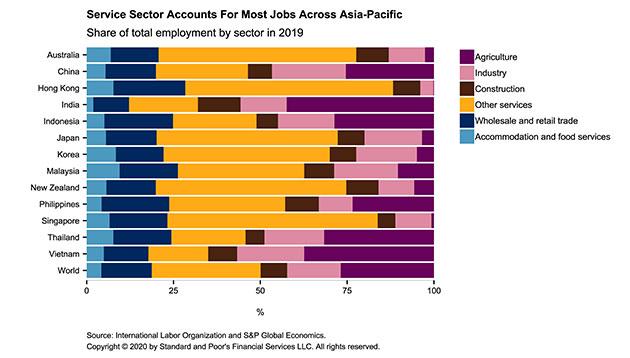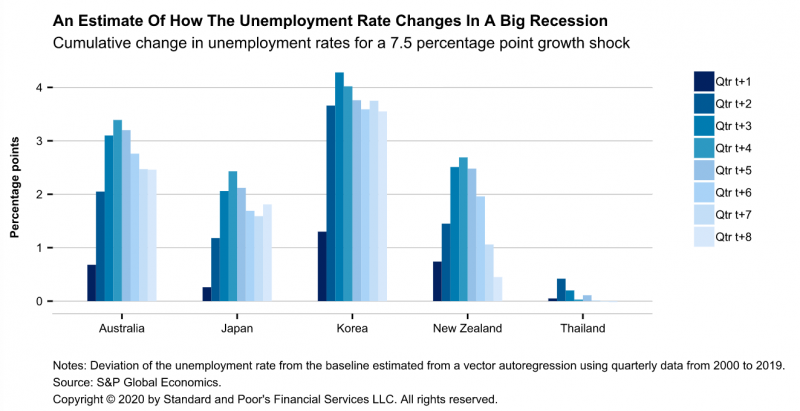share on
With COVID-19 undoubtedly impacting economies, jobs around the world are at stake.
In Asia Pacific, unemployment rates are expected to be double that of the average recession, a new research by S&P Global has found. This comes as social distancing measures hit one of the largest contributors to job creation – the services sector.
“Jobs are at the core of the current economic crisis. Measures designed to limit viral spread are striking at the heart of the engine of job creation across Asia-Pacific – the service sector. The unfortunate truth about jobs in almost every economy in the world is that they are easily lost but hard to win back.” said Shaun Roache, Asia-Pacific Chief Economist, S&P Global.
According to the report, this sector has over the years become the most important employer across the region, accounting for most of the jobs in existence.

Additionally, in terms of job loss – the report highlighted how unemployment rates might rise in countries as a result of the outbreak’s hit to growth, in selected economies such as Japan, Australia, Korea, New Zealand, and Thailand.
In Thailand, for instance, the unemployment rate hardly moved, which was attributed possibly to problems with underlying data; while it was expected to range from about 2 percentage points (pp) in Japan to above 4pp in Korea.

Apart from this, it was revealed that while jobs may be easy to lose, they are harder to win back, partly due to costs, even when recovery takes place.
Further, there may also be an impact on hiring – wherein, workers who have been able to retain their jobs during this period already possess the knowledge and skills to do the job, and are thus able to negotiate higher salaries. As a result, hiring additional workers at higher wage rates becomes less attractive to employers.
That said, while workers may retain their jobs, some do face the possibility of a cut in their working hours, which thus results in lower pays. Per the report, the rising share of part-time and casual employment could mean hours change more and jobs less than in previous cycles.
For nine economies across Asia Pacific where data was available, part-time jobs now account for almost 25% of total employment, with the highest shares in Australia, Japan, and Indonesia at about 32%.
Policies may help curb the rise in unemployment, but only for the short-term
To encourage employers to keep workers on the payroll and to keep paying them close to their normal wage, policymakers across countries are taking their own strategic approach.
Based on the report, for example, Singapore, Hong Kong, Australia and New Zealand have taken the most direct approach of directly subsidising wages up to a certain amount and for a specified period.
However, these are seen as short-term fixes, as incentives for these policies are expected to wane after the initial six months, for the following reasons.
First, as they are exceptionally expensive for governments. Second, they usually still impose a cash flow burden on firms. For both governments and firms, the cost-benefit trade-off will deteriorate over time, the report added.
What is the outlook like?
Overall, COVID-19 will “put unusually intense upward pressure on unemployment rates and downward pressure on hours worked compared to previous recessions,” the report stated.
In the absence of large and targeted wage subsidy schemes, it is estimated that unemployment rates would rise by well over 3pp across the region, much more than the typical recession; the higher it rises, the more drawn-out recovery is expected to be, which also depends on social distancing restrictions.
Last, job losses are expected to hit household debt-servicing capacity, encourage higher saving, and lower consumption, with Australia, Korea, Malaysia, and Thailand the most exposed.
Human Resources Online is on Telegram! Follow us @humanresourcesonline or click here for all the latest HR and manpower news from around the region.
Photo / 123RF
share on
Follow us on Telegram and on Instagram @humanresourcesonline for all the latest HR and manpower news from around the region!
Related topics


